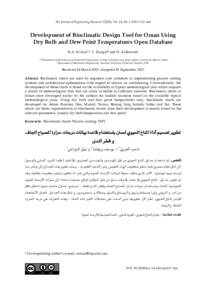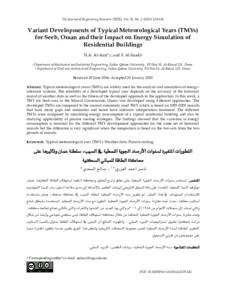Document
Development of bioclimatic design tool for Oman using dry bulb and dew point temperatures open database.
Contributors
Zurigat, Y., Author
Al-Rawahi, N., Author
Publisher
Sultan Qaboos University.
Gregorian
2017
Language
English
Subject
English abstract
Bioclimatic charts are used by engineers and architects in implementing passive cooling systems and architectural optimization with respect to natural air conditioning. Conventionally, the development of these charts is based on the availability of typical meteorological year which requires a record of meteorological data that are rarely available in sufficient amounts. Bioclimatic charts in Oman were developed earlier by the authors for limited locations based on the available typical meteorological years. Using dry bulb and dew point temperatures only, bioclimatic charts are developed for Adam, Buraimi, Ibra, Muscat, Nizwa, Rustaq, Saiq, Salalah, Suhar and Sur. These charts are better representative of bioclimatic trends since their development is mainly based on the relevant parameters, namely dry bulb temperature and dew point.
Member of
ISSN
1726-6742
Resource URL
Arabic abstract
تم استخدام جداول المناخ الحيوي من قبل المهندسين والمهندسين المعماريين في تنفيذ أنظمة التبريد السلبي والوصول إلى أمثل نظام معماري فيما يتعلق بتكييف الهواء الطبيعي. ومن الناحية التقليدية، يستند تطوير هذه الجداول إلى توافر سنة أرصاد جوية نموذجية، الأمر الذي يتطلب سجلا لبيانات الأرصاد الجوية والتي نادرا ما تكون متوفرة بكميات كافية. وقد تم تطوير جداول المناخ الحيوي في عمان في وقت سابق من قبل المؤلفين لمواقع محدودة استنادا إلى سنوات الأرصاد الجوية النموذجية المتاحة. وباستخدام درجات حرارة المصباح الجاف وقطر الندى فقط، تم وضع جداول مناخية حيوية لمناطق كل من أدم والبريمي وإبراء ومسقط ونزوى والرستاق وسيق وصلالة وصحار وصور. وتمثل هذه الجداول أفضل الاتجاهات لقياس المناخ الحيوي نظرا لأن تطويرها مبني أساسا على معاملات التغير ذات الصلة، وهذه المتغيرات هي درجة الحرارة الجافة والرطبة.
Category
Journal articles


